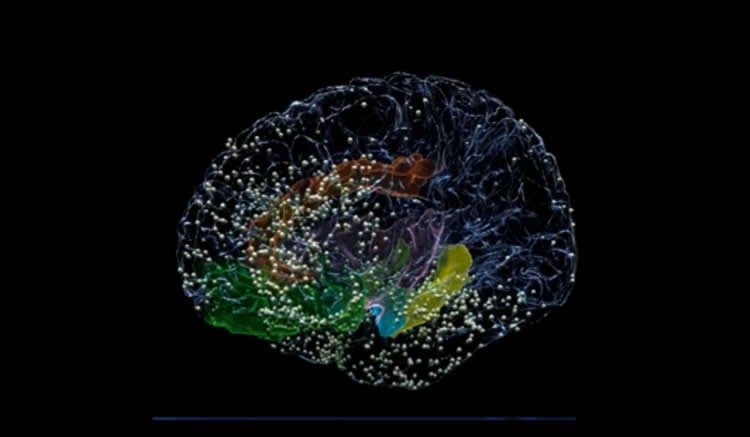Summary: Stimulating the lateral orbitofrontal cortex improves mood in those suffering from depression, a new study reveals.
Source: Cell Press.
Researchers have found an effective target in the brain for electrical stimulation to improve mood in people suffering from depression. As reported in the journal Current Biology on November 29, stimulation of a brain region called the lateral orbitofrontal cortex (OFC) reliably produced acute improvement in mood in patients who suffered from depression at the start of the study.
Those effects were not seen in patients without mood symptoms, suggesting that the brain stimulation works to normalize activity in mood-related neural circuitry, the researchers say.
“Stimulation induced a pattern of activity in brain regions connected to OFC that was similar to patterns seen when patients naturally experienced positive mood states,” says Vikram Rao, of the University of California, San Francisco. “Our findings suggest that OFC is a promising new stimulation target for treatment of mood disorders.”
The team led by Rao and Kristin Sellers in the lab of Edward Chang studied 25 patients with epilepsy who had electrodes placed in the brain for medical reasons to pinpoint the origin of their seizures. Many of those patients also suffered from depression, which is often seen in people with epilepsy. With the patients’ consent, Chang’s team took advantage of those electrodes to deliver small electrical pulses to areas of the brain thought to be involved in regulating mood.
Previous studies have explored deep brain stimulation (DBS) for mood disorders, but its success depends critically on target selection. Targets in other mood-related areas deep in the brain hadn’t always led to reliable improvements.
In the new study, the researchers focused their attention and the electrical stimulation on the OFC. The OFC is a key hub for mood-related circuitry. But it’s also widely regarded as one of the least well-understood brain regions.
“Although OFC is a more superficial target, it shares rich interconnections with several brain regions implicated in emotion processing,” Sellers says. That made this relatively small brain area an attractive target for therapeutic stimulation.

The researchers used the implanted electrodes to stimulate OFC and other brain regions while collecting verbal mood reports and questionnaire scores. Those studies found that unilateral stimulation of the lateral OFC produced acute, dose-dependent mood-state improvement in subjects with moderate-to-severe baseline depression. The changes in brain activity the researchers observed after stimulation closely resembled those seen when people are in a good mood.
The findings show that mood can be immediately improved by electrical stimulation of a relatively small area of brain, the researchers say. They also add to evidence that mood disorders are the result of dysfunction in brain circuits.
The researchers say that plenty of work remains before DBS could enter routine clinical practice. Chang’s team is currently exploring whether stimulation of OFC produces durable improvement in mood over longer periods of time. They also hope to develop a medical device for patients with treatment-resistant mood disorders that can monitor brain activity in OFC and stimulate only when needed to keep that activity within a healthy range.
“Ultimately, it would be ideal if activity in mood-related brain circuits could be normalized indefinitely without patients needing to do anything,” Rao says.
Funding: The study was funded by the National Institutes of Health (MH102242).
Source: Carly Britton – Cell Press
Publisher: Organized by NeuroscienceNews.com.
Image Source: NeuroscienceNews.com image is credited to Ben Speidel, Chang Lab, UCSF.
Original Research: Open access research for “Direct Electrical Stimulation of Lateral Orbitofrontal Cortex Acutely Improves Mood in Individuals with Symptoms of Depression” by Vikram R. Rao, Kristin K. Sellers, Deanna L. Wallace, Morgan B. Lee, Maryam Bijanzadeh, Omid G. Sani, Yuxiao Yang, Maryam M. Shanechi, Heather E. Dawes, and Edward F. Chang in Current Biology. Published November 29 2018.
doi:10.1002/ana.25377
[cbtabs][cbtab title=”MLA”]Cell Press”Effective New Target for Mood Boosting Brain Stimulation Found.” NeuroscienceNews. NeuroscienceNews, 29 November 2018.
<https://neurosciencenews.com/mood-brain-stimulation-10273/>.[/cbtab][cbtab title=”APA”]Cell Press(2018, November 29). Effective New Target for Mood Boosting Brain Stimulation Found. NeuroscienceNews. Retrieved November 29, 2018 from https://neurosciencenews.com/mood-brain-stimulation-10273/[/cbtab][cbtab title=”Chicago”]Cell Press”Effective New Target for Mood Boosting Brain Stimulation Found.” https://neurosciencenews.com/mood-brain-stimulation-10273/ (accessed November 29, 2018).[/cbtab][/cbtabs]
Abstract
Direct Electrical Stimulation of Lateral Orbitofrontal Cortex Acutely Improves Mood in Individuals with Symptoms of Depression
Mood disorders cause significant morbidity and mortality, and existing therapies fail 20%–30% of patients. Deep brain stimulation (DBS) is an emerging treatment for refractory mood disorders, but its success depends critically on target selection. DBS focused on known targets within mood-related frontostriatal and limbic circuits has been variably efficacious. Here, we examine the effects of stimulation in orbitofrontal cortex (OFC), a key hub for mood-related circuitry that has not been well characterized as a stimulation target. We studied 25 subjects with epilepsy who were implanted with intracranial electrodes for seizure localization. Baseline depression traits ranged from mild to severe. We serially assayed mood state over several days using a validated questionnaire. Continuous electrocorticography enabled investigation of neurophysiological correlates of mood-state changes. We used implanted electrodes to stimulate OFC and other brain regions while collecting verbal mood reports and questionnaire scores. We found that unilateral stimulation of the lateral OFC produced acute, dose-dependent mood-state improvement in subjects with moderate-to-severe baseline depression. Stimulation suppressed low-frequency power in OFC, mirroring neurophysiological features that were associated with positive mood states during natural mood fluctuation. Stimulation potentiated single-pulse-evoked responses in OFC and modulated activity within distributed structures implicated in mood regulation. Behavioral responses to stimulation did not include hypomania and indicated an acute restoration to non-depressed mood state. Together, these findings indicate that lateral OFC stimulation broadly modulates mood-related circuitry to improve mood state in depressed patients, revealing lateral OFC as a promising new target for therapeutic brain stimulation in mood disorders.







